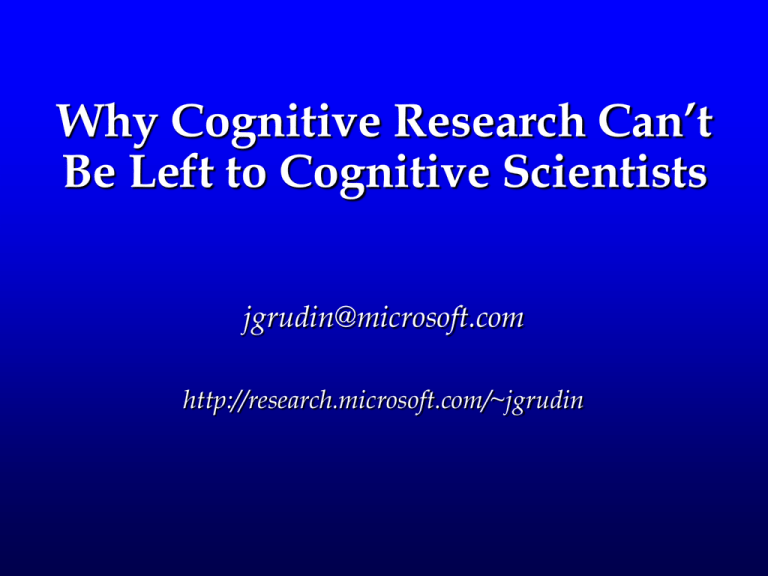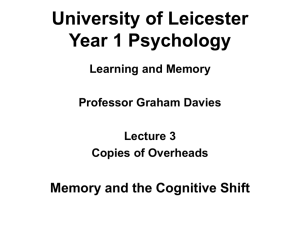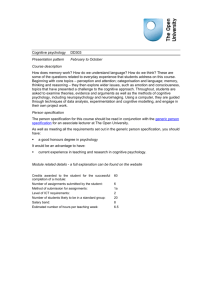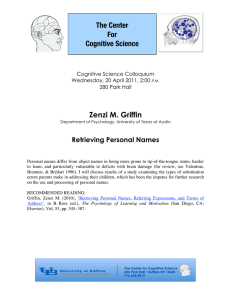Why Cognitive Research Can't Be Left To Cognitive Scientists
advertisement

Why Cognitive Research Can’t Be Left to Cognitive Scientists jgrudin@microsoft.com http://research.microsoft.com/~jgrudin Cognitive Science and HCI • • • • • • • • • • • 1968-1972 1972-1973 1973-1976 1976-1977 1977-1981 1981-1983 1983-1986 1986-1989 1989-1991 1991-1998 1998- BA, Math-Physics, Reed MS, Mathematics, Purdue Programmer, Wang Labs Psychology Department, Stanford UC San Diego (PhD, Cognitive Pych) MRC Applied Psychology Unit Software Engineer, Wang Labs Member of Technical Staff, MCC Professor, Aarhus Professor of Inf. & CS, UC Irvine Senior Researcher, Microsoft Research Cognitive Science and HCI • • • • • • 1968-1972 1972-1973 1973-1976 1976-1977 1977-1981 1981-1983 Tom Malone George Furnas Jeff Johnson John Black BA, Math-Physics, Reed MS, Mathematics, Purdue Programmer, Wang Labs Psychology Department, Stanford UC San Diego (PhD, Cognitive Pych) MRC Applied Psychology Unit Bob Glushko Gary Perlman Tom Erickson Allen Cypher Jim Hollan Steve Draper Ed Hutchins Liam Bannon Allan MacLean Catherine Marshall Nick Hammond Phil Barnard… Cognitive Science and HCI • • • • • • 1968-1972 1972-1973 1973-1976 1976-1977 1977-1981 1981-1983 BA, Math-Physics, Reed MS, Mathematics, Purdue Programmer, Wang Labs Psychology Department, Stanford UC San Diego (PhD, Cognitive Pych) MRC Applied Psychology Unit Don Norman, UCSD Dave Rumelhart, “” Herb Clark, Stanford Micha Pavel, Stanford Gary Olson, Michigan Peter Polson, Col. Judy Olson, Michigan John Black, Yale Roger Schvaneveldt, New Mexico Don Foss, Texas… CHI’83 was overwhelmingly psychologists Coming in on the Wave Distributed teams Inter-organizational Three Kinds of Computer User (60s-70s) • Operators (hands-on users of displays, printers, input devices) • Programmers (using flowcharts, paper coding sheets) • Users of reports and other output (reading text and viewing graphical output) Two threads of humancomputer interaction research The Receding Wave • KLM and GOMS • GUIs • Bridging the islands Few cognitive scientists are interested. Stranded on the Beach • Searching for shelter • Cultivating new crops – – – – – Capturing design rationale Computer supported cooperative work Ubiquitous and pervasive computing Universal accessibility … Cognitive Science and HCI • • • • • • • • • • • 1968-1972 1972-1973 1973-1976 1976-1977 1977-1981 1981-1983 1983-1986 1986-1989 1989-1991 1991-1998 1998- BA, Math-Physics, Reed MS, Mathematics, Purdue Programmer, Wang Labs Psychology Department, Stanford UC San Diego (PhD Cognitive Pych) MRC Applied Psychology Unit Software Engineer, Wang Labs Member of Technical Staff, MCC Professor, Aarhus Professor of Inf. & CS, UC Irvine Senior Researcher, Microsoft Research Shifting Focus of Interface Development Levels of Development Levels: Users: 1 2 Programmers Specialists: EE/CS 3 End-users 4 Groups HF&E & Psychology Methods: Benchmarks Events: Millisecs & hours Lab experiment Secs Mins 5 Hours 6 Organizations Anthro & Management Observation Weeks & months Generality and precision High Low Evaluation cost Low High Opportunity (Seen From Outside) • Some traditional foci of cognitive / IS research – – – – Decision making Organization of information (printed or displayed) Management of IT Knowledge management • Major expansion: direct hands-on use by everyone From Few to Many From Few to Many Five Parts of Organizations (Mintzberg, 1984) Strategic Apex Technostructure Middle Line Support Staff Operating Core Executives, Managers, Individuals Strategic Apex Middle Line Operating Core Direct, Hands-On Technology Use • 1980’s: “Managers don’t type.” – Perin study of resistance by tech company managers • 1990’s: Managers as late adopters – CEO use rose from 21% (1989) to 76% (2002) • 2000’s: Managers as early adopters • Why the change? – – – – – – New features & applications useful to managers Graphical interfaces made learning & use easier Use by friends, colleagues, at home helped learning Use by professionals & kids erased secretarial stigma (1993) Young individual contributors became middle-aged managers Old managers disappeared Direct, Hands-On Technology Use • 1980’s: “Managers don’t type.” – Perin study of resistance by tech company managers • 1990’s: Managers as late adopters – CEO use rose from 21% (1989) to 76% (2002) • 2000’s: Managers as early adopters • Implications – New process considerations for design, acquisition, deployment – New technology possibilities appear – Old technology possibilities disappear – Ways of using technology differ Widely Distributed Applications • Email • Shared calendars • Real-time communication & application sharing • Shared workspaces • Browsers • IM? • Desktop video? • Vertical applications Activity In Organizations Strategic Apex Middle Line Operating Core Activity In Organizations Strategic Apex Middle Line Operating Core Activity In Organizations Strategic Apex Middle Line Operating Core Activity In Organizations Strategic Apex Middle Line Operating Core Thank you… jgrudin@microsoft.com http://research.microsoft.com/~jgrudin Going from Few to Many Hands-on Users • Computers • Automobiles From human-computer interaction to digitally mediated human interaction From focus on displays and controls to focus on traffic Conventions and Conformity Interaction well-defined, predictable behaviors to achieve greater efficiency or safety Result: One set of behaviors? – No, some groups don’t interact with each other – No, some groups have different constraints






